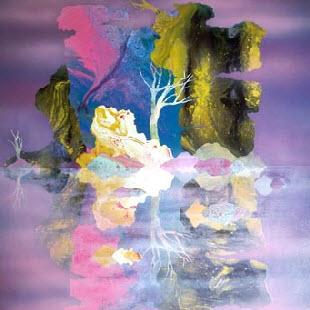Kate Shaw – Underground Sun: Nellie Castan Gallery
The presentation of Kate Shaw’s new series Underground Sun at the Nellie Castan Gallery was surprisingly harmonious. Shaw is well known for her vibrant, euphoric colour and I questioned how a number of large scale works would sit together in an enclosed space. The number of works, however, were tastefully sparse to allow each to occupy its own viewing space without encroachment or competition. The gallery itself was dim whilst the works illuminated from above seemed to emerge from the darkness. This lighting effect, more commonly associated with archaeology or medieval history collections, provided a reverent setting in which one could emotively commune with the work.
Shaw’s inspiration derived from a period of residency in the Northern Territory where she reflected upon the different interpretations of the Australian landscape. Shaw noted “a tension between the physical beauty and the cultural importance of what is on the surface and what is underneath; the uranium, the zinc, the gold and other mineral wealth”. This series is unique for Shaw in that the landscapes are representative of an actual place as opposed to her previous more “otherworldly” incarnations wherein the emphasis is on the psychology or the internal landscape.
The triptych Precipice can be considered the key work in this exhibition, holding pride of place on the wall adjacent to the entry. It is the work that most strongly evokes the spirit of the Northern Territory. Interestingly, Shaw’s triptych Eternal Sunshine, recently highlighted in the ABC’s Artscape program was relegated to the foyer. Considering that this series has heralded a new approach to the creative process of production for Shaw, this is perhaps not surprising. Eternal Sunshine appears as an exploratory lab, a pre-curser to the works in the main gallery. It doesn’t quite fit in terms of spirit and strength of composition; relying on a heavy overlay of pattern rather than the more subtle and irregular repetition of form found in Precipice. That said, the remainder of the exhibition is brilliantly exquisite, particularly upon close inspection.
Whilst the techniques of previous series, the use of the spray gun and the element of accident in the pouring or marbling of painted surfaces are still evident, they are furthered by the addition of collage. Overall Shaw’s work has a two dimensional quality; an overriding penchant for form which can with lesser artists denigrate into motif. Her collage technique, however, provides an intriguing level of depth which can only be surmised in the flesh. Subtle overlapping of forms, textured blobs of paint, glitter, iridescent and metallic pigments are all deeply embedded in thick coat of resin which acts to both highlight and obscure these characteristics making surface viewing simultaneously frustrating and wondrous.
One of the strengths of Shaw’s work is that it transcends time and place. The works function as actual landscapes indicative of the Northern Territory but also as a universal place recognised by all. Moreover they are simultaneously of the moment and of the past. The idea of ‘monument’ has been a prominent theme in previous series, with images of icebergs, and also presents in the Underground Sun in the form of the lone tree. Shaw “was drawn to the tree form when observing the top end landscape, as they grew in unlikely places and in any conditions, such as flooded wetlands, wedged between a rocky precipice or clinging to a rocky cliff”. For Shaw these monumental forms represent survival and endurance. They are markers in the memory of the landscape; a connection between the present and the past.
Finally in relating Shaw’s work to the historical tradition of landscape painting, one finds kinship with Caspar David Friedrich most particularly evident in the image entitled Lumen. Unlike Friedrich whose craggy, forlorn trees served to highlight man’s mortality and solidarity against a savage nature, Shaw’s works are far from haunting but rather inspirational. They are the sublime as seen quite literally through rose coloured glasses, wherein all the ‘horror’ is removed, leaving only the beauty.
The Underground Sun is now showing at the Nellie Castan Gallery from July 30 until August 22. Open Tuesday to Saturday from 12pm until 5pm. Located at level 1/12 River Street, South Yarra.





